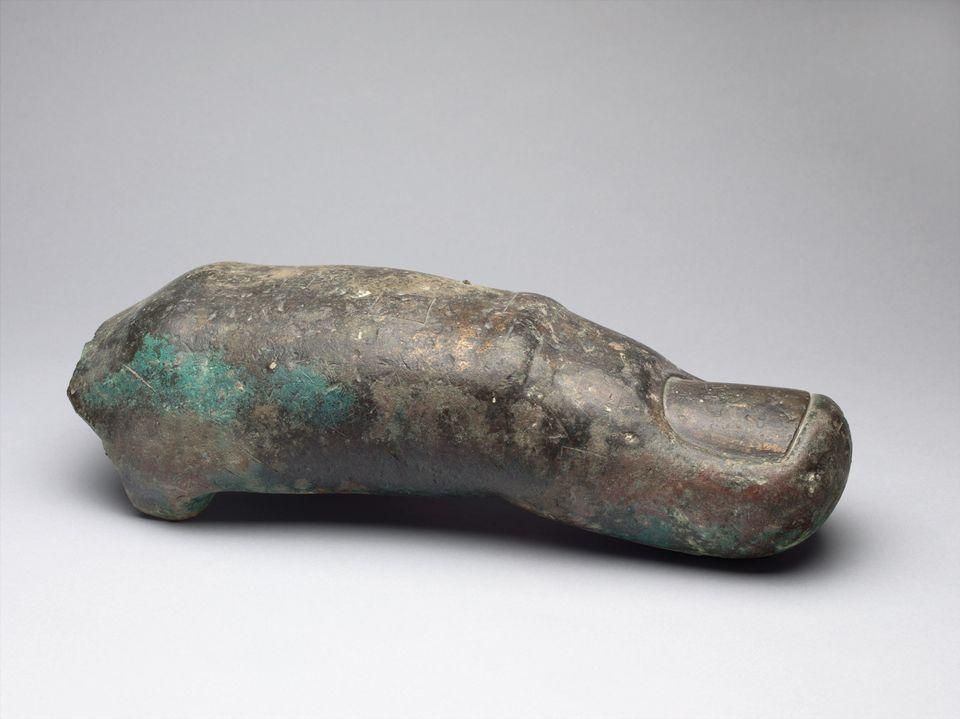Colossal Bronze Statue of Roman Emperor Reunited With Its Long-Lost Finger
Curators at the Louvre had mistakenly categorized the missing digit as a toe. An eagle-eyed researcher noticed the mistake in 2018
:focal(415x232:416x233)/https://tf-cmsv2-smithsonianmag-media.s3.amazonaws.com/filer/a0/38/a038430c-554e-475e-bdef-15a7d51a7519/statue.png)
After 500 years, scholars have finally solved a jigsaw puzzle of colossal proportions. This week, Rome’s Capitoline Museums announced that a giant bronze sculpture thought to depict the emperor Constantine was recently reunited with one of its missing pieces: namely, its enormous, 14.9-inch-long index finger.
Curators reattached the finger, which had previously been housed at Paris’ Louvre Museum, during a ceremony at the Capitoline Museums on Wednesday, reports Angela Giuffrida for the Guardian.
Museum director Claudio Parisi Presicce tells Italian newspaper Il Messaggero that the long-lost bronze digit was reunited with the emperor’s hand “using a non-invasive, reversible and invisible system,” per the Guardian.
The missing digit had resided in France since the 1860s, when prominent Italian art collector Giampietro Campana donated it and other prized antiquities to the Louvre. In 1913, curators mistakenly classified the digit as a “Roman toe,” wrote Vincent Noce for the Art Newspaper in 2018.
It wasn’t until more than 100 years later that an eagle-eyed researcher, Aurélia Azéma, realized the object’s true origins. In 2018, Azéma was studying ancient welding techniques when she realized that the severed finger matched the casting method and approximate size of the Capitoline Museums’ bronze emperor.
According to a statement, researchers Françoise Gaultier and Claudio Parisi Presicce confirmed Azéma’s hunch by analyzing a 3-D model of the Louvre finger. They then created an exact fiberglass replica of the missing phalange. When curators placed the fiberglass model on the original hand, the two objects fit together seamlessly, leaving no doubt that the mislabeled “toe” was the missing digit in question.
“After almost 500 years, thanks to synergy with the Louvre Museum, the hand of the colossal bronze statue of Constantine has been reassembled,” said Rome’s mayor, Virginia Raggi, during the ceremony, as quoted by Italian news agency ANSA and translated via Google Translate.
She added that the event took place on the 550th anniversary of a key donation: In 1471, Pope Sixtus IV gifted several major ancient bronze works—including this statue of Constantine—to the people of Rome. According to the Capitoline Museums’ website, the donation is considered the “foundation” of the Italian cultural institution.
Sixtus’ gift also included the Capitoline She-Wolf, a massive bronze sculpture of a wolf nursing two human babies. (Popular lore suggests that Rome’s founders, twins Romulus and Remus, were abandoned as infants on the banks of the Tiber River and raised by wolves.)
The emperor’s bronze likeness dates to the early fourth century A.D. It stood about 39 feet tall, sporting a now-lost crown and holding a large sphere in its hand, per the Art Newspaper. Of the original structure, only the head, the sphere, the left forearm, the hand that held the sphere and a few fingers have survived to the present day.
Dopo quasi 500 anni grazie alla sinergia tra @Roma e il @MuseeLouvre è stata ricomposta la mano della statua colossale in bronzo di Costantino, con il frammento del dito della Collezione Campana che è stato finora a Parigi: https://t.co/GVulChWzwD pic.twitter.com/EHvJ9iqPm2
— Virginia Raggi (@virginiaraggi) April 29, 2021
As the Art Newspaper notes, the statue depicts Constantine the Great, the first Roman emperor to embrace Christianity, or his third son and successor, Constantius II. Written descriptions of the fragmented monument first appear in the mid-12th century, when the pieces were still housed in the papal collections, according to the museum statement.
Scholars think the sphere was separated from the rest of the sculpture and displayed publicly on the Appian Way, a major road in the Roman Empire, in the late 1500s. The index finger may have also become separated from the emperor’s hand at that point, reports the Guardian.
The finger will remain on long-term loan to the Roman museum, writes ANSA. Now that the digit has been reunited with the hand, researchers hope to answer lingering questions about its travels over the centuries. Per the statement, scholars have yet to understand how the object ended up in Campana’s collection during the first half of the 19th century.
In her remarks, Raggi described the ceremony as a fitting way of marking the reopening of Rome’s museums, which have been closed for months due to the Covid-19 pandemic.
She added, “This is a beautiful way to reopen the museums, a way to welcome citizens and tourists who will finally be able to see the recomposed work.”
/https://tf-cmsv2-smithsonianmag-media.s3.amazonaws.com/accounts/headshot/nora.png)
/https://tf-cmsv2-smithsonianmag-media.s3.amazonaws.com/filer/00/1f/001f0b18-e070-469a-ba29-1a7fdb3dc0b7/hand.png)

/https://tf-cmsv2-smithsonianmag-media.s3.amazonaws.com/accounts/headshot/nora.png)